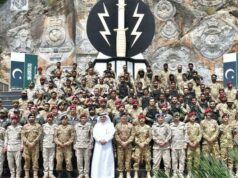By Colonel Awadhesh Kumar, Special Forces Veteran
India is a ever growing World Economic Power and already the sixth largest economy as per GDP in American dollar terms and third largest in PPP terms. It is also an Asian military Power and a growing World Military Power. However it faces two nuclear armed regional adversaries – Pakistan and China. So naturally the IAF has to be ready 24×7 to defend the Indian airspace against all kinds of aerial threats including nuclear missiles. It also has to be prepared for a two front war, if it is ever thrust on India. In this context at present IAF is worryingly short of combat aircraft.
The post 1962 assessment said that the IAF needs 45 combat squadrons (each with 18 aircraft) to meets its operational tasks. However, it never took into account a two front Scenario and the ever growing responsibility in the Indian Ocean Region from Madagascar to Malacca Strait. 54 Squadrons will just giving it a minimum breathing space, whereas 65 Squadrons are required to enable the IAF to meet its responsibilities without getting tensed.Though currently it has just 35 squadrons – including 10 squadrons of Russian MiG BISONS and MIG 27 fighters still left with some juice to carry on the fight if forced to do so. The Govt of India should have given the IAF replacements for these MIGs by 2010 itself.
The domestically developed Tejas light combat aircraft, which by now should have been serving the IAF with at least 15 Squadrons ( out of 65) will take another about 10 years to reach these numbers with its MK1, MK1A and Mk2 variants. To achieve this MoD, IAF and HAL will need to go all out for the same. The Sukhoi-30MKI, which India builds under licence from Russia, will be reaching its planned 15 Squadrons soon. As no other inductions have been finalized, except the two squadrons of Rafale jets, it becomes imperative that these enter service without any hitch.
After evicting the Congress led UPA govt, the new NDA govt led by Modi at once set out to rectify the decade long neglect of Indian Defence. The sloth set in by Saint Antony needed to be energised by fast-tracking the introduction of modern weaponry. A tender for 126 fighter aircraft had been in limbo for over a decade. The previous government had been dragging on with the negotiations with Dassault Company for Rafale fighters, seemingly oblivious of the Operational emergency.
Pushing the deal through, especially for building the jets in India was beyond question because of Antony’s indifference for so many years. Hence after consulting the IAF, the CCS led by Modi announced its cancellation in favour of a government-to-government purchase of 36 ready-built planes,the minimum as stated by the IAF, during his visit to Paris in 2015. These 36 aircrafts would be many times superior than what was being negotiated till date and the Comparative cost would still be cheaper ( when adding the cost of new avionics, weapons and sensors).
Now it seems that as part of a nefarious sinister scheming game plan, the Indian Supreme Court has suddenly received a petition that calls for an investigation into the government’s purchase of 36 Rafale fighter jets made by French company Dassault Aviation for an allegedly inflated 7.85 billion euros (US$8.96 billion). At stake is not just the modernisation of the Indian Air Force’s (IAF’s) ageing fleet, but also the very security of the Nation. A side gain may accrue to the disjointed Indian Opposition party by way of some mud by chance sticking to the good image of Prime Minister Narendra Modi, who came to power in 2014 promising to end corruption. With elections due in early 2019, the opposition seems to have at least something to strike at the Govt.
The only matter which needs clarification by the Dassault Company and may be the French Govt too as to the reason for choosing Anil Ambani – an Indian industrialist with no experience in aerospace manufacturing to set up a joint venture with Dassault to benefit from so-called offset provisions linked to the contract. The government of India has clearly stated that it has no role in the choice. Dassault had exercised its own choice in selecting Ambani as a partner.
The funny thing is that the opposition led by the very party which had toyed with India’s defence preparedness for so many years is charging the government with weakening the IAF by buying only 36 fighters.
It claims that this deal has undermined India’s aerospace industry by scuppering the plan to build the jets in India, and indulging in “crony capitalism” to benefit Ambani. Then how will they explain the UPA’s lethargy on TEJAS project all these years.
The government has denied all the charges and has rightly ruled out the opposition’s demand for a joint parliamentary investigation, realising that this would provide a public platform for political theatrics. Beside the Supreme Court, Simultaneously, the Comptroller and Auditor General (CAG), is also scrutinising the Rafale deal.
Even with all these accusations striking directly at the prime minister who is considered a “strong leader”, world wide, Modi with his good work continues to enjoy credibility among the masses. Opposition has not been able to make any dent, in spite of shouting against the highly needed demonetisation of high-value banknotes and the introduction of a countrywide goods and services tax. Only the self styled heavy intellectuals and “ seculars” have been criticising hoarse but the public remains unwilling to blame Modi fir all these bitter but much needed medicines.
All their hope is now on at least some criticism from the Supreme Court or CAG. Both of them have no business to ask as to why IAF chose Rafael. They can only examine if due process was followed by the MoD and the CCS at arriving at the final decision.
The IAF will start receiving the Rafael fighters from next year and the last one should be in by early 2021. MoD has already initiated a fresh tender last April for another 114 medium-range combat aircraft. Dassault has offered the Rafale in this tender as well and theoretically enjoys a head start, over the six other fighters in the fray: Boeing’s F/A-18E Super Hornet, Lockheed Martin’s F-16 Block 70, SAAB’s Gripen E, Eurofighter GmbH’s Typhoon, and Russia’s MiG-35 and Sukhoi-35.
The French jets are also being considered in an Indian Navy tender for 57 fighters for its two upcoming aircraft carriers. In this contract, the Rafale would compete against the Boeing F/A-18E/F Super Hornet. The best bet for India will be to go in for the combined deal with the French. They in turn should be ready to clinch the deal by lowering their price and give few add on.



